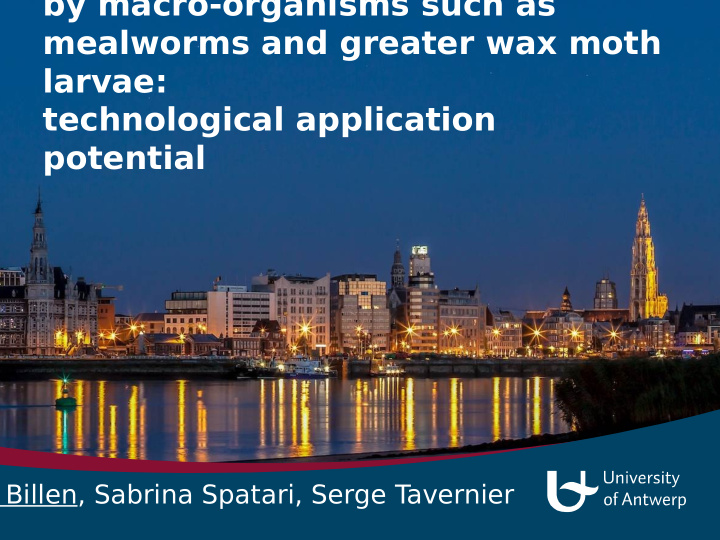



by macro-organisms such as mealworms and greater wax moth larvae: technological application potential r Billen, Sabrina Spatari, Serge T avernier
Background The Guardian T ue 25 Apr 2017 2
Experiments Format Species Substrate Time Experiment code Live Galleria Loosely folded cling fjlm 17 h live GWM _1 larvae mellonella (LDPE) Loosely folded cling fjlm 89 h live GWM _2 (LDPE) Folded layers cling fjlm 96 h live GWM _3 (LDPE) Loosely folded black bag 216 h live GWM _4 (LDPE) T enebrio Loosely folded cling fjlm 38 days live MW _1 molitor (LDPE) Commercial fruit bag (LDPE) 38 days live MW _2 None (blank) 38 days live MW _3 Bran 38 days live MW _4 Homogen Galleria Cling fjlm (LDPE) 48 h paste GWM _1 ate mellonella Cling fjlm (LDPE) at 100 % RH 20 h paste GWM _2 Cling fjlm (LDPE) and blank 0 – 120 paste GWM _3 paste h Liquid paraffjn at 100 % RH 14 days paste GWM _paraffj n Polystyrene (PS) powder at 14 days paste GWM _PS 100 % RH 3 T enebrio Liquid paraffjn at 100 % RH 14 days paste MW _paraffj
Live larvae with polyethylene 4
Degradation by biomass paste? No gravimetric changes No glycol (confjrming Weber et al. 2017) Weber, C., Pusch, S., Opatz, T. Current Biol 27, R731–45 (2017) 5
How do they do it? Food for thought… 6
T echnology potential Thévenot al. 2018 9.5 to 11 J per mealworm per day Brandon et al. 2018 Mealworms of 75-85 mg each 0.05 to 0.35 mg per day 1 to 7.5 J per mealworm per day 49% CO 2 42 MJ/kg 51% PE in faeces Microplastics? 0.35 mg PE per day (Brandon et al.) to 0.45 mg (calculated, Thévenot et al.) Thévenot, A., Rivera, J.L., Wilfart, A., Maillard, F ., Hassouna, M., Senga-Kiesse, T., Le Féon, S., Aubin, J. J Clean Prod Brandon, A.M., Gao, S.H., Tian, R., Ning, D., Yang, S.S., Zhou, J., Wu, W.M., Criddle, C.S. Env Sci T 170, 1260-1267 (2018) echnol 52, 6526-6532 (2018) 7
T echnology potential 0.35 mg PE per day (Brandon et al.) to 0.45 mg (calculated, Thévenot et al.) Zheng et al. (2013): mealworms in 76 days to 176 mg Ooninckx & de Boer (2012): 55 mWh of grid electricity Functional unit: 240 mWh of natural gas complete consumption of 1 tonne 0.22 L of water per mealworm of PE fjlm (without additional food) by 35-day old mealworms 5.5 to 7.1 tonnes in an additional 32 days of mealworms required Biomass growth? Valorization of frass? Electricity 290 EUR to 370 EUR Revenue from biodiesel? Natural gas 500 EUR to 642 EUR 790 EUR to 1112 EUR per tonne of PE treated Zheng, L., Hou, Y ., Li, W., Yang, S., Li, Q., Yu, Z. Appl Energ 101, Oonincx, D.G.A.B., de Boer, I.J.M. PLOS One 7(12), e51145 (2012) 618-621 (2013). 8
Yet… there may be value paste GWM _paraffin paste GWM _PS wax moth larvae with paraffin wax moth larvae with polystyrene M B B M S S blank larvae paste (B) paste MW _paraffin paste MW _PS blank substrate (S) mealworms with paraffin mealworms with polystyrene treated mixture (M) M BM M B M S S 9
Conclusions • Destruction (degradation) of PE is not OK, especially not without energetic valorization • No feasible remediation technology Preference for other nutrition (even • cannibalism) Ubiquity and abundance issues • Microplastics • • Fundamental biological insights are interesting • Indications of paraffjn functionalization: promising for biochemical process? 10
Invitation for collaboration Pieter Billen BioGEM research group University of Antwerp (Belgium) pieter.billen@uantwerp.be Sabrina Spatari Serge Tavernier Civil and Environmental BioGEM research group Engineering University of Antwerp (Belgium) T echnion (Israel) serge.tavernier@uantwerp.be sabrinas@technion.ac.il 11
Recommend
More recommend